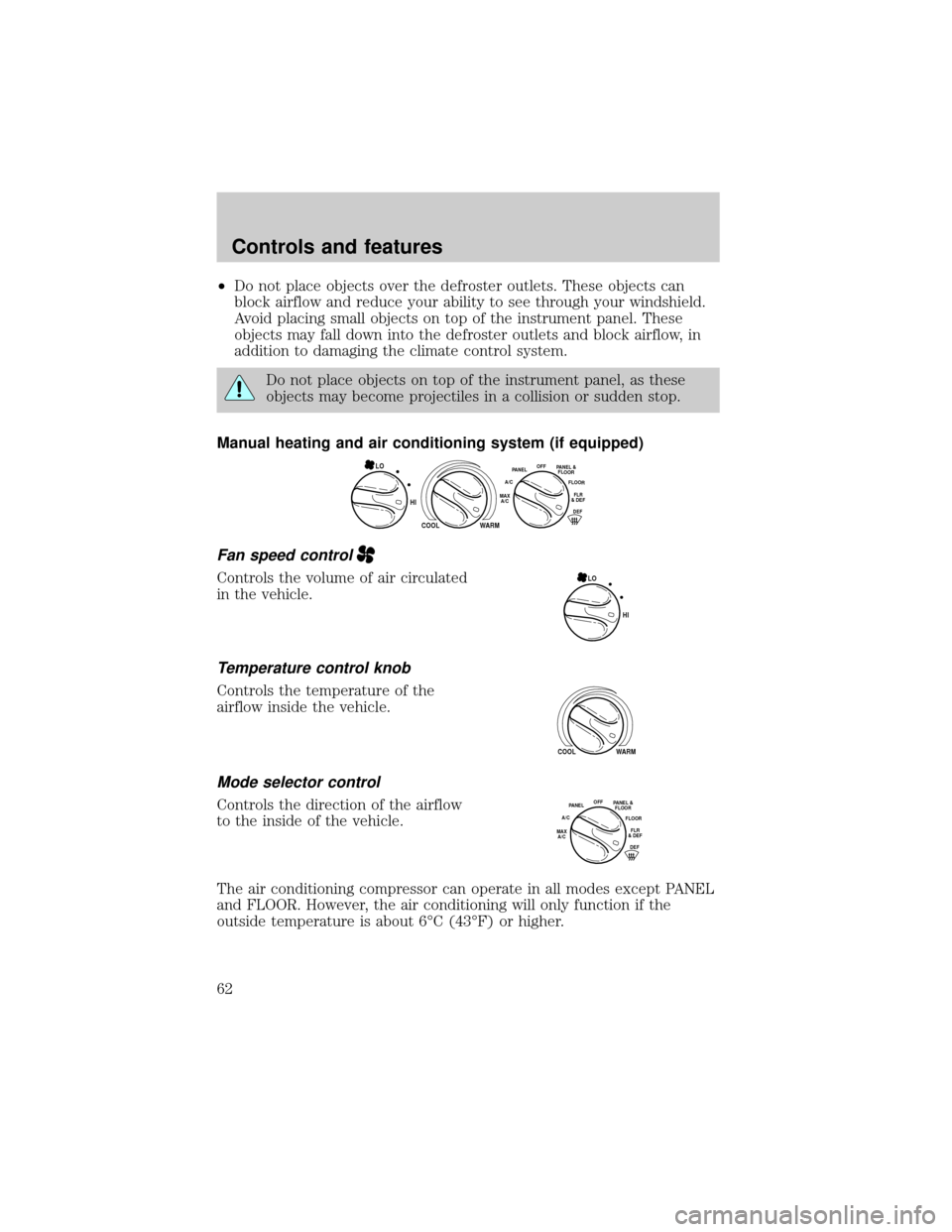2000 FORD F150 air conditioning
[x] Cancel search: air conditioningPage 62 of 280

²Do not place objects over the defroster outlets. These objects can
block airflow and reduce your ability to see through your windshield.
Avoid placing small objects on top of the instrument panel. These
objects may fall down into the defroster outlets and block airflow, in
addition to damaging the climate control system.
Do not place objects on top of the instrument panel, as these
objects may become projectiles in a collision or sudden stop.
Manual heating and air conditioning system (if equipped)
Fan speed control
Controls the volume of air circulated
in the vehicle.
Temperature control knob
Controls the temperature of the
airflow inside the vehicle.
Mode selector control
Controls the direction of the airflow
to the inside of the vehicle.
The air conditioning compressor can operate in all modes except PANEL
and FLOOR. However, the air conditioning will only function if the
outside temperature is about 6ÉC (43ÉF) or higher.
HI
COOL WARM
OFFPANEL
A/CFLOOR
DEFFLR
& DEFMAX
A/C
PANEL &
FLOORLO
HI LO
COOL WARM
OFFPANEL
A/CFLOOR
DEFFLR
& DEFMAX
A/C
PANEL &
FLOOR
Controls and features
62
Page 63 of 280

Since the air conditioner removes considerable moisture from the air
during operation, it is normal if clear water drips on the ground under
the air conditioner drain while the system is working and even after you
have stopped the vehicle.
²MAX A/C-Uses recirculated air to cool the vehicle. MAX A/C is noisier
than A/C but more economical and will cool the inside of the vehicle
faster. Airflow will be from the instrument panel registers. This mode
can also be used to prevent undesirable odors from entering the
vehicle.
²A/C-Uses outside air to cool the vehicle. It is quieter than MAX A/C
but not as economical. Airflow will be from the instrument panel
registers.
²PANEL -Distributes outside air through the instrument panel registers.
However, the air will not be cooled below the outside temperature
because the air conditioning does not operate in this mode.
²OFF-Outside air is shut out and the fan will not operate. For short
periods of time only, use this mode to prevent undesirable odors from
entering the vehicle.
²PANEL &FLOOR-Distributes outside air through the instrument panel
registers and the floor ducts. Heating and air conditioning capabilities
are provided in this mode. For added customer comfort, when the
temperature control knob is anywhere in between the full hot and full
cold positions, the air distributed through the floor ducts will be
slightly warmer than the air sent to the instrument panel registers.
²FLOOR -Allows for maximum heating by distributing outside air
through the floor ducts. However, the air will not be cooled below the
outside temperature because the air conditioning does not operate in
this mode.
²FLOOR & DEFROST ±Distributes outside air through the windshield
defroster ducts and the floor ducts. Heating and air conditioning
capabilities are provided in this mode. For added customer comfort,
the air distributed through the floor ducts will be slightly warmer than
the air sent to the windshield defroster ducts. If the temperature is
about 6ÉC (43ÉF) or higher, the air conditioner will automatically
dehumidify the air to reduce fogging.
²DEF
(Defrost)-Distributes outside air through the windshield
defroster ducts. It can be used to clear ice or fog from the windshield.
If the temperature is about 6ÉC (43ÉF) or higher, the air conditioner
will automatically dehumidify the air to reduce fogging.
Controls and features
63
Page 137 of 280

Guarding against exhaust fumes
Although odorless and colorless, carbon monoxide is present in exhaust
fumes. Take precautions to avoid its dangerous effects.
If you ever smell exhaust fumes of any kind inside your vehicle,
have your dealer inspect and fix your vehicle immediately. Do
not drive if you smell exhaust fumes. These fumes are harmful and
could kill you.
Have the exhaust and body ventilation systems checked whenever:
²the vehicle is raised for service.
²the sound of the exhaust system changes.
²the vehicle has been damaged in a collision.
WARNING:Engine exhaust, some of its constituents, and
certain vehicle components contain or emit chemicals known to
the State of California to cause cancer and birth defects or other
reproductive harm. In addition, certain fluids contained in vehicles and
certain products of component wear contain or emit chemicals known
to the State of California to cause cancer and birth defects or other
reproductive harm.
Important ventilating information
If the engine is idling while the vehicle is stopped in an open area for
long periods of time, open the windows at least 2.5 cm (one inch).
Adjust the heating or air conditioning (if equipped) to bring in fresh air.
Improve vehicle ventilation by
keeping all air inlet vents clear of
snow, leaves and other debris.
Starting
137
Page 211 of 280

Vehicles driven year-round in non-extreme climates should use a 50/50
mixture of engine coolant and distilled water for optimum cooling system
and engine protection.
What you should know about fail-safe cooling (if equipped)
If the engine coolant supply is depleted, this feature allows the vehicle to
be driven temporarily before incremental component damage is incurred.
The ªfail-safeº distance depends on ambient temperatures, vehicle load
and terrain.
How fail-safe cooling works
If the engine begins to overheat:
²the engine coolant temperature
gauge will move to the red (hot)
area.
²the
symbol will illuminate.
²the
symbol will illuminate.
²theService Engine Soon
indicator light will illuminate.
If the engine reaches a preset over-temperature condition, the engine
will automatically switch to alternating cylinder operation. Each disabled
cylinder acts as an air pump and cools the engine.
When this occurs the vehicle will still operate. However:
²the engine power will be limited.
²the air conditioning system will be disabled.
Continued operation will increase the engine temperature:
²the engine will completely shut down.
²steering and braking effort will increase.
Once the engine temperature cools, the engine can be re-started. Take
your vehicle to a service facility as soon as possible to minimize engine
damage.C
H
Maintenance and care
211
Page 273 of 280

A
Accessory delay ..........................79
Air bag supplemental
restraint system ........................113
and child safety seats ............114
description ..............................113
disposal ....................................117
driver air bag ..........................115
indicator light ...................12, 116
operation .................................115
passenger air bag ...................115
passenger
deactivation switch ...........65, 117
Air cleaner filter .......220±221, 247
Air conditioning ..........................60
Ambulance packages ....................3
Antifreeze
(see Engine coolant) ................206
Anti-lock brake system
(see Brakes) ......................139±140
Anti-theft system
warning light .............................13
Armrests ....................................102
Audio system (see Radio) .........24
Automatic transmission ............144
driving an automatic
overdrive .................................145
fluid, adding ............................213
fluid, checking ........................213
fluid, refill capacities ..............248
fluid, specification ..................253
Auxiliary power point .................23
Axle
lubricant specifications ..251, 253
refill capacities ........................248
traction lok ..............................142B
Battery .......................................218
acid, treating emergencies .....218
charging system
warning light .............................13
jumping a disabled battery ....190
maintenance-free ....................218
replacement, specifications ...247
servicing ..................................218
voltage gauge ............................18
Belt minder ...............................108
Brakes ........................................138
anti-lock ...........................138±140
anti-lock brake system (ABS)
warning light .....................13, 140
brake warning light ..................12
fluid, checking and adding ....204
fluid, refill capacities ..............248
fluid, specifications .........251, 253
lubricant specifications ..251, 253
parking ....................................141
pedals (see Power
adjustable foot pedals) ............22
shift interlock ..........................144
Break-in period .............................3
C
Capacities for refilling fluids ....248
Cassette tape player ...................36
CD changer .................................54
Certification Label ....................257
Child safety restraints ..............122
child safety belts ....................122
Child safety seats ......................123
attaching with tether straps ..128
in front seat ............................125
in rear seat ......................125, 127
Index
273
Page 274 of 280

Cleaning your vehicle ...............242
engine compartment ..............243
exterior ............................243, 246
exterior lamps .........................244
instrument cluster lens ..........245
instrument panel ....................245
interior .....................................245
plastic parts ............................244
safety belts ..............................245
washing ....................................242
waxing .....................................242
wheels ......................................243
wiper blades ............................244
Climate control (see Air
conditioning or Heating) ............60
Clock ..........................28, 34, 45, 54
Clutch
fluid ..........................................204
operation while driving ..........147
recommended shift speeds ....149
Compass, electronic ....................75
calibration .................................77
set zone adjustment .................76
Console
overhead ....................................73
Controls
power seat .................................99
Coolant
checking and adding ..............206
refill capacities ................210, 248
specifications ..................251, 253
Cruise control
(see Speed control) ....................67
Customer Assistance ................175
Ford accessories for your
vehicle .....................................266
Ford Extended
Service Plan ............................259Getting assistance outside
the U.S. and Canada ..............265
Getting roadside assistance ...175
Getting the
service you need ....................259
Ordering additional
owner's literature ...................270
The Dispute
Settlement Board ...................262
Utilizing the Mediation/
Arbitration Program ...............265
D
Daytime running lamps
(see Lamps) ................................20
Dipstick
automatic
transmission fluid ...................213
engine oil .................................200
Doors
door ajar warning .....................15
lubricant specifications ..........251
Driveline universal joint
and slip yoke .............................218
Driving under special
conditions ..........................158±159
mud ..........................................158
sand .........................................158
snow and ice ...........................159
through water .................158, 162
E
Emergencies, roadside
jump-starting ..........................190
Emission control system ..........235
Engine ........................................253
Index
274
Page 276 of 280

driving with a heavy load ......160
location ....................................160
GVWR (Gross
Vehicle Weight Rating) .............160
calculating .......................160, 162
definition .................................160
driving with a heavy load ......160
location ....................................160
H
Hazard flashers .........................176
Headlamps ...................................20
aiming ......................................242
autolamp system .......................22
bulb specifications ..................241
daytime running lights .............20
flash to pass ..............................20
high beam ...........................13, 20
replacing bulbs .......................237
turning on and off ....................20
warning chime ..........................15
Heating ........................................60
heater only system ...................60
heating and
air conditioning system ............62
Hood ..........................................198
I
Ignition .................................66, 253
removing the key ....................153
Infant seats
(see Safety seats) .....................123
Inspection/maintenance
(I/M) testing ..............................236
Instrument panel
cleaning ...................................245
cluster ................................10, 245lighting up
panel and interior .....................21
location of components ............10
J
Jack ............................................185
positioning ...............................185
storage .....................................185
Jump-starting your vehicle ......190
K
Keyless entry system
autolock .....................................91
locking and unlocking doors ....95
programming entry code .........95
Keys
key in ignition chime ...............15
positions of the ignition ...........66
removing from the ignition ....153
L
Lamps
autolamp system .......................22
bulb replacement
specifications chart ................241
cargo lamps ...............................21
daytime running light ...............20
fog lamps ...................................21
headlamps .................................20
headlamps, flash to pass ..........20
instrument panel, dimming .....21
interior lamps ...........................77
replacing bulbs ...............236±241
Lane change indicator
(see Turn signal) ........................66
Lights, warning and indicator ....10
air bag ........................................12
Index
276